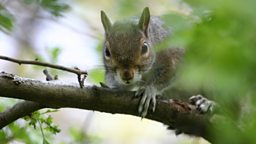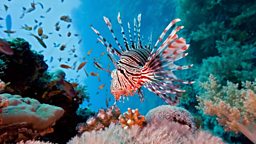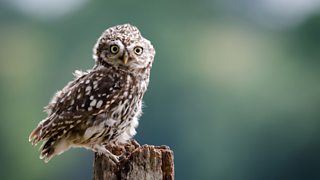Seven of the world's most infamous animal invaders
Some creatures thrive in areas that aren’t their natural habitat – having often been introduced there (either deliberately or accidentally) by humans. These invasive species can have a negative impact on the local ecosystem, causing all sorts of issues for the indigenous animals who call that place home.
From mammals to molluscs, here are seven of the world’s most troublesome animal invaders.
1. Camels causing outrage in the Australian outback

Survival in the Aussie outback is a tall order for plants, animals and people. Food and water are in short supply so if anyone, or anything, takes too much it can spell disaster. Unfortunately, camels are doing just that. These one-humped herbivores were brought over by the Europeans in the mid 1800s to be used as working animals. But by the 1930s trucks and trains had put the camels out of a job and, released into the wild, they thrived.
It’s estimated that there are now around 400 to 600 thousand dromedaries going walkabout in the bush, hogging water supplies that provide a lifeline for native creatures like dingoes, wallabies and birds. And with camels drinking 2000 times the volume of Australia’s largest native mammal, the red kangaroo, they drain waterholes quickly. These thirsty intruders cause havoc for the indigenous people too, for whom the waterholes are considered sacred. New manmade drinking sources are being introduced in the hope of drawing the camels away from natural waterholes, and programs are in place to cull and harvest the desert dwellers for meat. But, with numbers so high, the camels are there to stay.
2. Grey squirrels spreading disease in Britain’s woodlands

Originally a native of North America, grey squirrels were deemed a fashionable addition to our country estates and were deliberately released into the wild in Great Britain in 1876. But their assimilation has had a devastating effect on our native red squirrel population. Not only are their grey counterparts bigger and stronger (and therefore more likely to survive the winter and produce more young) but they also carry a pox virus that the red squirrel has no immunity to. This has led to the red squirrel being largely wiped out across the British Isles, with only around 150,000 remaining in the wild.
Fortunately, the red squirrels still have a stronghold in Scotland where there are major conservation projects aiming to protect them.
3. Raucous tropical parakeets proliferating in London

Take a stroll through a park in England’s capital and you’ll inevitably come across a vibrant green bird with a loud squawk. These are, remarkably, ring-necked parakeet’s – the city’s “posh pigeons”. How did these tropical parrots, native to West Africa and India, begin breeding in England? One theory is that the current population descended from birds that escaped from Shepperton Studios during filming of The African Queen. Some think the original birds were escapees of an aviary in Syon Park, which was damaged by debris from a plane passing overhead. And one rumour even tells of Jimi Hendrix releasing the birds on Carnaby Street in the 1970s.
Although the tropical interlopers provide a welcome splash of colour in an often grey city, sadly, they may be having a negative impact on our native feathered friends. Recent studies have shown that parakeets tend to scare smaller garden birds away from feeding and nesting sites with their intimidating, gregarious behaviour.
4. Pesky pythons proving a pest in the Florida Everglades

Burmese pythons are proliferating in the Everglades National Park in Florida. The first pythons are thought to have been a handful of escaped pets, but since then numbers of the snake have swelled exponentially – not surprising when a single female lays up to 100 eggs!
Growing to vast proportions and with a voracious appetite, these snakes are overtaking alligators as the habitat’s top predator – and deer, raccoons, rabbits, bobcats and possums are in sharp decline in some areas. Unfortunately, this slithering pest is a master of disguise, with even experts finding the snake impossible to spot in grass. As a result, no one really knows how many pythons are hiding in the Florida wilderness…
5. Lionfish dominating Caribbean coral reefs

The red lionfish is native to the Pacific Ocean but since the 1990s this beautiful and extremely venomous fish – with few predators – has been multiplying in the Western Atlantic, with an invasion spreading throughout the Caribbean islands and the Gulf of Mexico. Nobody is sure how the lionfish reached these waters: it could be that they were released into the ocean when Hurricane Andrew demolished a Florida seafront aquarium, or they may have been abandoned pets.
Whatever their origin, these swarms are destroying the Caribbean ecosystem, with the lionfish able to consume up to 80 per cent of an area’s small reef fish in the space of just a few weeks. With some reefs off Florida and South Carolina now harbouring 1,000 per acre, lionfish hunting has become a popular sport. Lionfish rodeos involve spearing and removing as many lionfish as possible in a day, in a drive to protect the fragile marine ecosystem.
6. American mink making a meal of the British water vole

An American native, mink were brought over to Britain in the late 1920s to be farmed for their glossy fur. But creatures that escaped these fur farms began breeding in the British countryside and, without natural predators, the mink population thrived.
The mink is an aggressive and skilful killer and since their assimilation the UK’s native water vole population has experienced the most rapid decline of any British wild mammal. They are now lost from 94% of areas where they were once prevalent and – although habitat loss is a factor – it’s no coincidence that the acceleration of their decline coincided with the spread of the American mink.
7. Zebra mussels muscling in on the Great Lakes

Native to the Black and Caspian seas, Zebra mussels are thought to have been introduced to the Great Lakes of USA and Canada via the ballast water of ships (used to maintain a ship’s balance).
These striped molluscs are considered to be one of the most aggressive freshwater invaders on the planet because their numbers escalate so quickly. And with massive populations filtering the waters, there is little plankton and algae left to feed native fish or mussels. Commonly found on the bottom of boats, many ships are inspected for signs of the pesky zebra mussel before they leave a port.
-
![]()
Costing the Earth: Outback Outrage
The Australian outback is under attack from a surprising enemy - the camel.
-
![]()
Plants can do much more than we might think. So is it wrong to eat them?
-
![]()
Fascinating facts to celebrate our favourite nocturnal bird, the wise old owl.
-
![]()
Reasons to love mud from people who make mud a way of life.




